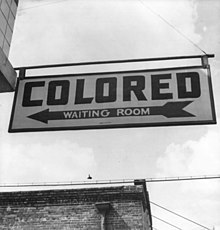
Back العزل العنصري في الولايات المتحدة Arabic Segregació racial als Estats Units Catalan جیاکردنەوەی ڕەگەزی لە ویلایەتە یەکگرتووەکانی ئەمریکا CKB جدایی نژادی در ایالات متحده آمریکا Persian Ségrégation raciale aux États-Unis French Ռասայական սեգրեգացիա ԱՄՆ-ում Armenian Pemisahan suku bangsa di Amerika Serikat ID Segregazione razziale negli Stati Uniti d'America Italian Rassensegregatie in de Verenigde Staten Dutch Segregacion raciala als Estats Units Occitan

Facilities and services such as housing, healthcare, education, employment, and transportation have been systematically separated in the United States based on racial categorizations. Segregation was the legally or socially enforced separation of African Americans from whites, as well as the separation of other ethnic minorities from majority and mainstream communities.[1] While mainly referring to the physical separation and provision of separate facilities, it can also refer to other manifestations such as prohibitions against interracial marriage (enforced with anti-miscegenation laws), and the separation of roles within an institution. The U.S. Armed Forces were formally segregated until 1948, as black units were separated from white units but were still typically led by white officers.[2]
| Part of a series of articles on |
| Racial and ethnic segregation |
|---|
 |
| Part of a series on the |
| Nadir of American race relations |
|---|
 |

In the 1857 Dred Scott case (Dred Scott v. Sandford), the U.S. Supreme Court found that Blacks were not and never could be U.S. citizens and that the U.S. Constitution and civil rights were not applicable to them. Congress passed the Civil Rights Act of 1875, but it was overturned by the U.S. Supreme Court in 1883 in the Civil Rights Cases. The U.S. Supreme Court upheld the constitutionality of segregation in Plessy v. Ferguson (1896), so long as "separate but equal" facilities were provided, a requirement that was rarely met.[4] The doctrine's applicability to public schools was unanimously overturned in Brown v. Board of Education (1954). In the following years the court further ruled against racial segregation in several landmark cases including Heart of Atlanta Motel, Inc. v. United States (1964), which helped bring an end to the Jim Crow laws.[5][6][7][8]
Segregation was enforced across the U.S. for much of its history. Racial segregation follows two forms. De jure segregation mandated the separation of races by law, and was the form imposed by slave codes before the Civil War and by Black Codes and Jim Crow laws following the war. De jure segregation was outlawed by the Civil Rights Act of 1964, the Voting Rights Act of 1965, and the Fair Housing Act of 1968.[9] De facto segregation, or segregation "in fact", is that which exists without sanction of the law. De facto segregation continues today in such closely related areas as residential segregation and school segregation because of both contemporary behavior and the historical legacy of de jure segregation.[10]
- ^ C. Vann Woodward, The Strange Career of Jim Crow (3rd ed. 1947).
- ^ Harvard Sitkoff, The Struggle for Black Equality (2008)
- ^ Robertson, Karen (June 2, 2020). "The Long Struggle for Freedom Rights". Ohio History Center. Archived from the original on January 16, 2021.
- ^ Margo, Robert A. (1990). Race and Schooling in the South, 1880–1950: An Economic History. Chicago: University of Chicago Press. p. 68. ISBN 978-0226505107.
- ^ "Brown v. Board of Education of Topeka (1)". Oyez. Retrieved September 24, 2019.
- ^ "Heart of Atlanta Motel, Inc. v. United States". Oyez. Retrieved September 24, 2019.
- ^ "The Court's Decision – Separate Is Not Equal". americanhistory.si.edu. Retrieved September 24, 2019.
- ^ "The Rise and Fall of Jim Crow. A National Struggle . The Supreme Court | PBS". www.thirteen.org. Retrieved September 24, 2019.
- ^ Judy L. Hasday, The Civil Rights Act of 1964: An End to Racial Segregation (2007).
- ^ Krysan, Maria; Crowder, Kyle (2017). Cycle of Segregation: Social Processes and Residential Stratification. New York: Russell Sage Foundation. ISBN 978-0871544902.
© MMXXIII Rich X Search. We shall prevail. All rights reserved. Rich X Search